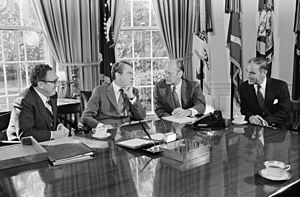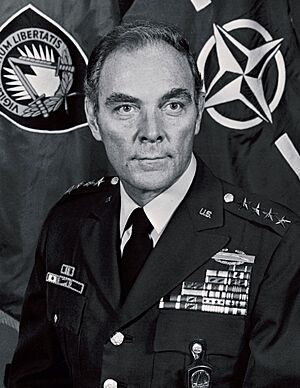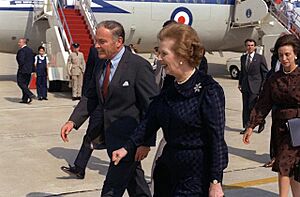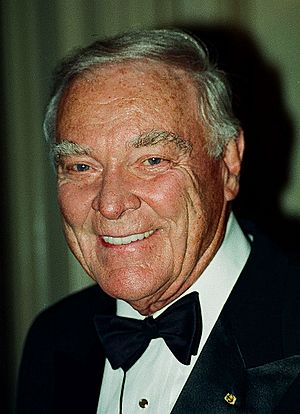Alexander Haig facts for kids
Quick facts for kids
Alexander Haig
|
|
|---|---|
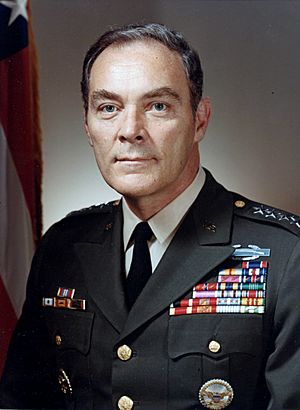
General Alexander Haig, c. 1974
|
|
| 59th United States Secretary of State | |
| In office January 22, 1981 – July 5, 1982 |
|
| President | Ronald Reagan |
| Deputy | William P. Clark Jr. Walter J. Stoessel Jr. |
| Preceded by | Edmund Muskie |
| Succeeded by | George Shultz |
| 7th Supreme Allied Commander Europe | |
| In office December 15, 1974 – July 1, 1979 |
|
| President | Gerald Ford Jimmy Carter |
| Deputy | John Mogg Harry Tuzo Gerd Schmückle |
| Preceded by | Andrew Goodpaster |
| Succeeded by | Bernard W. Rogers |
| 5th White House Chief of Staff | |
| In office May 4, 1973 – September 21, 1974 |
|
| President | Richard Nixon Gerald Ford |
| Preceded by | H. R. Haldeman |
| Succeeded by | Donald Rumsfeld |
| Vice Chief of Staff of the United States Army | |
| In office January 4, 1973 – May 4, 1973 |
|
| President | Richard Nixon |
| Preceded by | Bruce Palmer Jr. |
| Succeeded by | Frederick C. Weyand |
| United States Deputy National Security Advisor | |
| In office June 1970 – January 4, 1973 |
|
| President | Richard Nixon |
| Preceded by | Richard V. Allen |
| Succeeded by | Brent Scowcroft |
| Personal details | |
| Born |
Alexander Meigs Haig Jr.
December 2, 1924 Bala Cynwyd, Pennsylvania, U.S. |
| Died | February 20, 2010 (aged 85) Baltimore, Maryland, U.S. |
| Resting place | Arlington National Cemetery |
| Political party | Republican |
| Spouse |
Patricia Fox
(m. 1950) |
| Children | 3, including Brian |
| Education | United States Military Academy (BS) Columbia University (MBA) Georgetown University (MA) |
| Signature |  |
| Military service | |
| Allegiance | United States of America |
| Branch/service | |
| Years of service | 1947–1979 |
| Rank | |
| Battles/wars | Korean War Vietnam War |
| Awards |
|
Alexander Meigs Haig Jr. (born December 2, 1924 – died February 20, 2010) was an important American general and government official. He served as United States Secretary of State under President Ronald Reagan. Before that, he was White House Chief of Staff for Presidents Richard Nixon and Gerald Ford.
Haig was a general in the United States Army. He held high positions like vice chief of staff of the Army and Supreme Allied Commander Europe. In 1973, he became the youngest four-star general in the U.S. Army's history.
Contents
- Early Life and Education
- Military Career
- Security Adviser and Vice Chief of Staff (1969–1973)
- White House Chief of Staff (1973–1974)
- NATO Supreme Allied Commander (1974–1979)
- Civilian Positions
- Secretary of State (1981–1982)
- 1988 Presidential Campaign
- Later Life and Death
- Family
- Awards and Decorations
- Images for kids
- See Also
Early Life and Education
Alexander Haig was born in Bala Cynwyd, Pennsylvania. His father passed away when Haig was nine years old. His mother raised him and his two siblings.
He first went to Saint Joseph's Preparatory School and later graduated from Lower Merion High School in 1942. Haig then studied at the University of Notre Dame for two years.
In 1944, he was accepted into the United States Military Academy at West Point. He graduated in 1947. Later, he earned a master's degree in business from Columbia Business School in 1955. He also earned a master's degree in international relations from Georgetown University in 1961.
Military Career
Korean War Service
After graduating from West Point, Haig served in the Korean War. He worked as an aide to General Alonzo Patrick Fox and General Edward Almond. He helped with important events like the Battle of Inchon and the Battle of Chosin Reservoir. For his brave service, he received two Silver Star medals and a Bronze Star medal.
Working at the Pentagon
From 1962 to 1965, Haig worked as a staff officer at the Pentagon. He was a military assistant to the Secretary of the Army and then to the Secretary of Defense. In 1966, he completed his studies at the United States Army War College.
Vietnam War Service
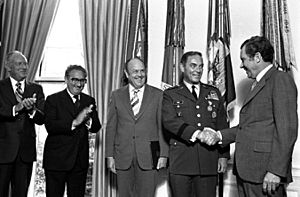
In 1966, Haig commanded a battalion in the 1st Infantry Division during the Vietnam War. In March 1967, his troops were surrounded by a larger enemy force. Haig flew in a helicopter to see the battle, and his helicopter was shot down. He was awarded the Distinguished Service Cross for his actions during this battle.
He also received the Distinguished Flying Cross and the Purple Heart during his time in Vietnam. He was promoted to colonel and commanded a brigade.
Return to West Point
After his tour in Vietnam, Haig returned to the United States. He became a regimental commander at West Point.
Security Adviser and Vice Chief of Staff (1969–1973)
In 1969, Haig became a military assistant to Henry Kissinger, who was the National Security Adviser. A year later, he became the deputy assistant for national security affairs. During this time, he was promoted to brigadier general and then major general.
He helped with peace talks for the Paris Peace Accords in 1972. In January 1973, he became vice chief of staff of the Army. This was the second-highest position in the Army.
White House Chief of Staff (1973–1974)
Working for President Nixon
In May 1973, Haig became the White House Chief of Staff for President Richard Nixon. This was during the time of the Watergate scandal. Haig played a key role in keeping the government running while President Nixon was dealing with the scandal. He also helped persuade Nixon to resign in August 1974.
Working for President Ford
After Nixon resigned, Haig briefly stayed on as Chief of Staff for the new President, Gerald Ford. He helped Ford with the changeover. Haig then left the White House to return to the Army in September 1974.
NATO Supreme Allied Commander (1974–1979)
In December 1974, President Ford appointed Haig as the Supreme Allied Commander Europe (SACEUR). This meant he commanded all NATO forces in Europe. NATO is a military alliance of countries that work together for defense.
As SACEUR, General Haig worked to make the relationship between the United States and other NATO countries stronger. He focused on improving training for U.S. troops in Europe. He also pushed for better equipment to prevent attacks in Western Europe.
On June 25, 1979, Haig was targeted in an assassination attempt in Belgium. A bomb exploded near his car, but he was not hurt. Three of his bodyguards were wounded. A group called the Red Army Faction was responsible.
Haig retired from the Army in July 1979.
Civilian Positions
After leaving the Army, Haig worked in the business world. He was president and director of United Technologies Corporation from 1979 to 1981. He also served on the board of directors for companies like MGM and America Online (AOL).
He hosted a television program called World Business Review for several years.
Secretary of State (1981–1982)
In 1981, President Ronald Reagan nominated Haig to be his United States Secretary of State. This is the top diplomat for the United States. Haig was the second career military officer to hold this position.
After the Reagan Assassination Attempt
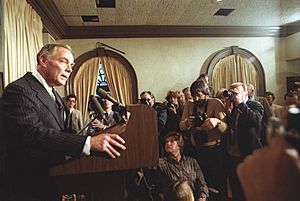
On March 30, 1981, there was an attempt to assassinate President Reagan. While Reagan was in the hospital, Haig told reporters, "I am in control here." He meant that he was managing the White House crisis until Vice President George H. W. Bush arrived. It's important to know that the United States presidential line of succession states that the Vice President, then the Speaker of the House, then the President pro tempore of the Senate, come before the Secretary of State in line to become president.
Falklands War
In April 1982, Haig tried to help make peace during the Falklands War. This was a conflict between Argentina and the United Kingdom over the Falkland Islands. Haig traveled between the two countries to try and find a solution, but his efforts were not successful.
Resignation
Haig often had disagreements with other members of President Reagan's administration. He decided to resign from his position as Secretary of State on June 25, 1982. President Reagan accepted his resignation on July 5. George P. Shultz became the new Secretary of State.
1988 Presidential Campaign
Haig ran for president in the 1988 Republican Party presidential primaries. He did not win the nomination. He often criticized George H. W. Bush, who was Vice President at the time. After not doing well in early voting, Haig ended his campaign and supported Bob Dole.
Later Life and Death
In 1980, Haig had heart surgery. After leaving the White House, he worked as a director for various businesses. He was also the host of the television program World Business Review.
On February 20, 2010, Alexander Haig passed away at the age of 85. He died from complications of an infection. He was buried at Arlington National Cemetery.
President Barack Obama said that General Haig "exemplified our finest warrior–diplomat tradition." Secretary of State Hillary Clinton said he "served his country in many capacities for many years."
Family
Alexander Haig was married to Patricia Fox. They had three children: Alexander Patrick Haig, Barbara Haig, and Brian Haig. His younger brother, Frank Haig, is a Jesuit priest and physics professor.
Awards and Decorations
Haig received many awards and decorations for his military service. Some of them include:
- Distinguished Service Cross
- Defense Distinguished Service Medal
- Army Distinguished Service Medal
- Navy Distinguished Service Medal
- Air Force Distinguished Service Medal
- Silver Star (with one oak leaf cluster)
- Legion of Merit (with two oak leaf clusters)
- Distinguished Flying Cross (with two oak leaf clusters)
- Bronze Star (with "V" device and two oak leaf clusters)
- Purple Heart
- Air Medal (with 27 awards)
- Combat Infantryman Badge
Images for kids
-
Alexander Haig official portrait as White House Chief of Staff.
-
General Haig with Secretary of State Henry Kissinger and his assistant Major George Joulwan (seated, corner left) at Haig's office in the White House, August 8, 1974.
-
A meeting of Nixon Administration economic advisors and cabinet members on May 7, 1974. Clockwise from Richard Nixon: George P. Shultz, James T. Lynn, Alexander Haig, Roy Ash, Herbert Stein and William E. Simon.
-
Haig with President Gerald Ford shortly after Ford assuming the Presidency at the Oval Office, White House in September 1974.
-
General Alexander Haig with President Jimmy Carter in the Oval Office, White House, December 19, 1978.
-
General Alexander Haig speaking at RAF Lakenheath on June 1, 1977.
-
Haig (seated, left) with President Ronald Reagan, Vice President George H. W. Bush and the rest of President Reagan's cabinet members in the Oval Office, January 28, 1981.
-
United States Secretary of State General Alexander Haig welcomed Israeli Prime Minister Menachem Begin at Andrews Air Force Base.
-
Secretary of State Alexander Haig accompanying President Ronald Reagan during a meeting with British Prime Minister Margaret Thatcher and British Foreign Secretary Francis Pym at 10 Downing Street, June 8, 1982.
See Also
 In Spanish: Alexander Haig para niños
In Spanish: Alexander Haig para niños


